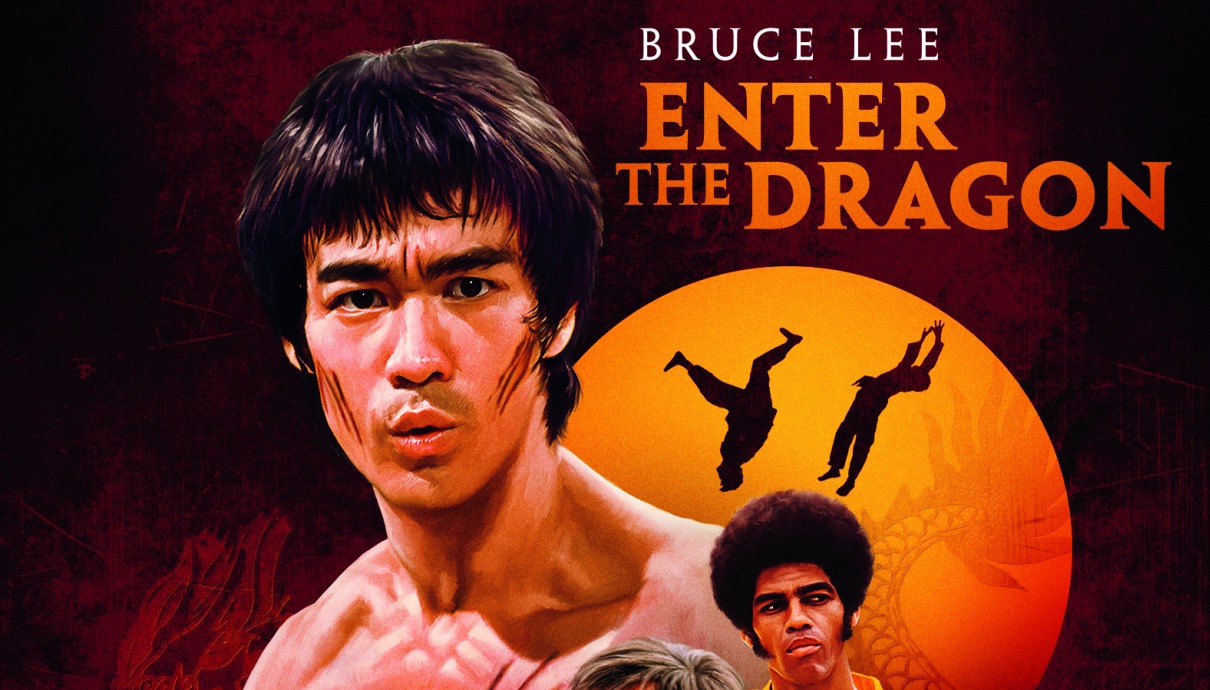Enter the Dragon (1973)

“Enter the Dragon,” directed by Robert Clouse and released in 1973, is widely regarded as a seminal film in the martial arts genre. This iconic film not only catapulted Bruce Lee into international stardom but also set a new standard for martial arts cinema. As a film that combines intense action with a compelling narrative, “Enter the Dragon” remains influential both in terms of its impact on cinema and its role in popularizing martial arts worldwide.
“Enter the Dragon” follows the story of Lee, a skilled martial artist played by Bruce Lee, who is recruited by a secretive intelligence agency to infiltrate a martial arts tournament hosted by the enigmatic crime lord Han (Shih Kien). Han’s island compound is rumored to be a front for his illicit drug operations, and Lee’s mission is to gather evidence and bring him to justice.
The film begins with a series of dramatic and action-packed sequences that establish Lee’s character and his martial arts prowess. After a dramatic opening scene, where Lee is seen training and reflecting on his philosophy of martial arts, he is approached by a government agent who asks him to participate in the tournament. Lee agrees, driven by personal vengeance and a sense of justice.
As Lee arrives at Han’s island, he encounters a diverse array of fighters and adversaries, each bringing their unique styles and personalities to the tournament. The film’s narrative intricately weaves together action, espionage, and personal vendettas. Lee’s quest for justice becomes more complicated as he uncovers the extent of Han’s criminal activities and faces off against formidable opponents.
The film culminates in a series of high-octane, choreographed fight scenes that showcase Lee’s unparalleled skill and athleticism. The final showdown between Lee and Han is both a climactic battle of physical prowess and a symbolic confrontation between good and evil.
The success of “Enter the Dragon” is in large part due to its memorable characters and the compelling performances of its cast:
Bruce Lee as Lee: Bruce Lee’s portrayal of Lee is both charismatic and intense. Lee’s performance combines physical agility with deep philosophical underpinnings, capturing the essence of a martial artist driven by both personal and moral convictions. His fight choreography, combined with his dynamic screen presence, makes his performance stand out as a defining moment in martial arts cinema. Lee’s contribution to the film earned him posthumous acclaim and solidified his legacy as a martial arts icon.
Shih Kien as Han: Shih Kien’s portrayal of the antagonist Han is equally memorable. Han is depicted as a cunning and ruthless crime lord with a personal vendetta against Lee. Kien’s performance conveys the character’s menacing authority and physicality, making him a formidable adversary. His portrayal is crucial in establishing the film’s central conflict and heightening the stakes of Lee’s mission.
John Saxon as Roper: John Saxon plays Roper, a former military man and skilled fighter who competes in the tournament. Saxon’s performance adds depth to the film’s ensemble, providing both comic relief and a sense of camaraderie among the fighters. Roper’s character serves as both an ally and a foil to Lee, enriching the film’s narrative.
Jim Kelly as Williams: Jim Kelly plays Williams, an African-American martial artist and friend of Roper. Kelly’s performance brings a sense of cool and charisma to the film, and his character’s contributions to the fight sequences are both stylish and impactful. Williams’ character also adds diversity to the film’s cast and highlights the global appeal of martial arts.

Robert Clouse’s direction of “Enter the Dragon” is characterized by its fast-paced and dynamic style, which reflects the film’s high-energy action sequences. Clouse’s approach to direction emphasizes the fluidity and grace of martial arts, incorporating a blend of wide shots and close-ups to highlight the physicality and precision of the fight scenes.
The film’s cinematography, led by Gilbert Hamad, captures the exotic locales and the intensity of the combat. The use of vibrant colors, particularly in the scenes set in Han’s island compound, creates a visually striking contrast between the natural beauty of the surroundings and the brutality of the violence. The cinematography enhances the film’s atmosphere, making it both visually captivating and narratively engaging.
The choreography of the fight scenes, orchestrated by Bruce Lee himself along with a team of skilled martial artists, is one of the film’s standout features. The fight sequences are meticulously crafted to showcase Lee’s martial arts abilities and to deliver a thrilling cinematic experience. The integration of traditional martial arts techniques with innovative choreography sets a new standard for action films.

“Enter the Dragon” explores several key themes through its narrative and characters:
Justice and Vengeance: The film’s central theme is the quest for justice and personal revenge. Lee’s mission to expose Han’s criminal activities is driven by a sense of duty and personal loss. The film examines the idea of justice as a form of both personal and societal retribution, highlighting the moral and ethical dimensions of Lee’s actions.
Good vs. Evil: The conflict between Lee and Han symbolizes the broader struggle between good and evil. Han’s criminal empire represents corruption and malevolence, while Lee’s character embodies righteousness and integrity. The final confrontation between the two characters is a climactic battle that underscores the film’s moral framework.
Martial Arts Philosophy: The film delves into the philosophy of martial arts, emphasizing concepts such as discipline, self-control, and the pursuit of inner harmony. Lee’s character embodies these principles, and his interactions with other fighters reflect his commitment to the deeper aspects of martial arts practice.
Cultural Exchange and Global Influence: “Enter the Dragon” represents a cultural exchange between Eastern and Western cinema, bringing martial arts to a global audience. The film’s success helped bridge cultural gaps and introduced audiences worldwide to the richness of martial arts traditions.

“Enter the Dragon” was released during a period of growing interest in martial arts and Asian cinema in the West. The film’s success coincided with the rising popularity of martial arts in popular culture, driven in part by Bruce Lee’s international appeal. The film’s impact on cinema extends beyond its genre, influencing subsequent action films and shaping the portrayal of martial arts in mainstream media.
The film’s release also occurred during a time of significant social and cultural change, including increased global awareness of Asian cultures and philosophies. “Enter the Dragon” contributed to a broader appreciation of martial arts and helped establish Bruce Lee as a cultural icon whose legacy continues to resonate in contemporary media.

“Enter the Dragon” (1973) is a groundbreaking film that has left a lasting legacy in both martial arts cinema and popular culture. Directed by Robert Clouse and featuring an unforgettable performance by Bruce Lee, the film combines exhilarating action with a compelling narrative and rich thematic content. Its innovative choreography, dynamic direction, and exploration of justice and cultural exchange have cemented its status as a classic. As a film that transcends its genre, “Enter the Dragon” continues to inspire and captivate audiences, reaffirming Bruce Lee’s enduring influence and the global appeal of martial arts cinema.






 Andor (Season 2) (2025)
Andor (Season 2) (2025)




